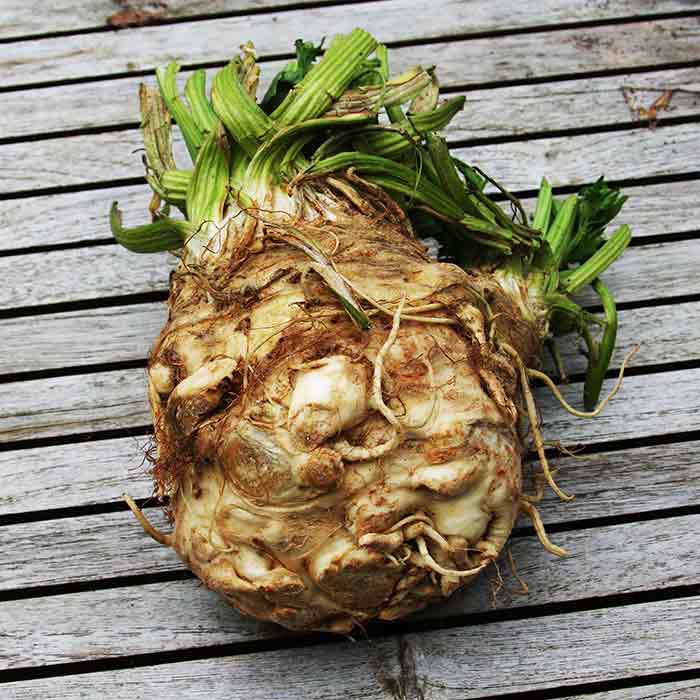If you are wondering about how to grow celeriac, you can grow it from seeds or seedling.
If you would like to grow it in the home garden seeds are readily available for sale from online suppliers or seedlings from local nurseries, usually in early spring.
What is celeriac?
Celeriac is related to celery, however it is the bulbous root that is eaten whereas with celery it is the tall green stems.
It is the flavour of the celeriac root that is the attraction. It has a nutty flavour, a little spicy, and little taste of celery. And this makes the best mash you can imagine, either by itself, or with other vegetables.
Cooked it makes a great addition to a number of dishes and recipes including the famous, Celeriac Remoulade. It can also be roasted, used in mash, soups or stews.

Raw it can be used to make a very interesting coleslaw, or it can be used in a a salad with a little olive oil or your favourite dressing. And for using Celeriac raw, you need good fresh bulbs and these are best home grown. So choose a variety and start planting.
How to Grow Celeriac at home
You can grow this wonderful vegetable from seed or from seedlings. The disadvantage of growing from seeds is that this is a slow grower.
The best time to plant celeriac into the garden is in spring. We suggest sowing seeds indoors or in a cold frame in late winter to give them a good start and then transplant to the vegetable garden as things warm up a little.
How to Grow Celeriac from Seeds
Celeriac seeds are very small, so difficult to handle as individual seeds. They are usually started indoors or in a cold frame.
- Plant them in punnets and be prepared to thin them.
- The seeds need to be surface sown as they need light to germinate.
- Seeds can take 4 – 6 weeks to germinate, so be patient.
- Keep them moist by mist spraying.
- Once they reach around 2 – 3 cm in height, pot them up into individual pots.
Planting Celeriac in the Garden
Choose a sunny to part shaded position and a humus rich well dug soil.
- Plant celeriac in a bed by itself.
- Add some leaf mould to assist with moisture retention if possible and some aged cow manure.
- Celeriac requires around 4 – 5 months to grow to mature size.
- Seedlings should be around 8 – 12 cms tall before planting out
- Wait until the danger of frosts has past before planting.
- Space seedlings at around 40cm apart, they need the space.
- Water once a week, or 2 – 3 times a week if the soil begins to dry.
- This is a slow plant to develop, its not until late summer that the bulb begins to swell.
- Keep the area free from weeds, snails and slugs.
Best fertiliser is a low nitrogen one as you are looking for root production, not foliage growth.
Harvesting
In autumn/fall dig the bulbs and store them in a cool dry dark position.
You can leave them in the ground until late autumn/ fall but be carful of very wet soils snails and slugs.
Problems
We hear that many home gardeners find that celeriac does not form a bulb.
- If you plant celeriac into cold ground it can decide that it is the second season of its life cycle (its a biennial) and instead of growing the root, it goes straight to setting seed.
- Other gardeners plant the seedling to deeply, the crown must remain just above ground level, which leads to the next issue of water, planted with crown so high, drying out is a problem. Lack of water is a problem once planted out, this is a vegetable that does not like dry conditions.
- Frosts are a problem, this is not a frost hardy plant.
- Most information on growing celeriac mentions full sun, however much of this is from the UK and not really relevant to warmer climate zones. In hot summers, a little afternoon shade can be desirable to prevent drying out.
- Sandy soils are also a problem, a rich loamy soil is ideal.
Celeriac varieties
Remember that different varieties will grow to different sizes :
- Prinz is probably the best variety
- Giant Prauge is another good variety as are Monarch and Rowena.
- Monarch has large bulbs and a smoothish skin, easier to peel.
- Bianco del Veneto has smaller bulbs and much less edible flesh than Prinz, however it has finer texture.
How to prepare Celeriac forCooking
- You need to remove the top and the bottom, so leaves and roots are cut off to real the white flesh.
- Then you remove the skin. All of this is best done with a large knife as most vegetable peelers are not up to handling this bumpy character.
- After that you ready to cut it up to use in your favourite recipe,
READ ABOUT
Organic Fertilizers
Growing Vegetables in Containers
Fruit Trees
Berry Plants
Seed Potatoes
Growing Tomatoes
Growing Saffron
